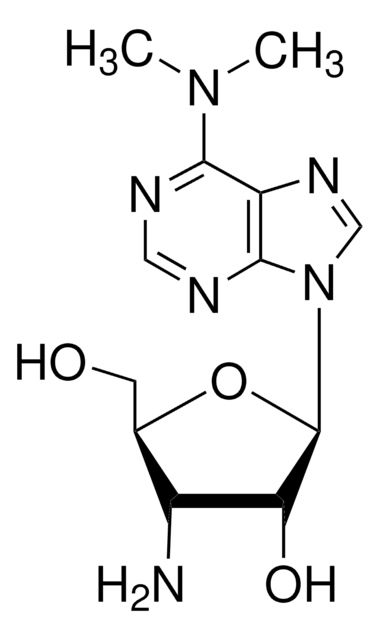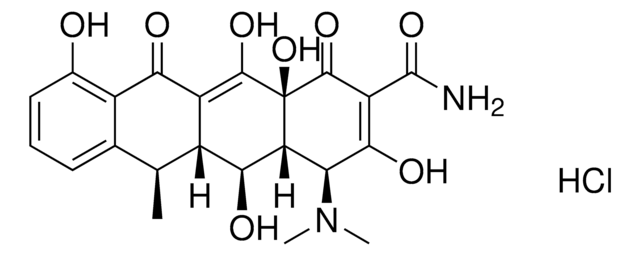Wichtige Dokumente
SBR00017
Puromycin aminonucleoside Ready Made Solution
10 mg/mL in water
Synonym(e):
3′-Amino-3′-deoxy-N6,N6-dimethyladenosine
About This Item
Empfohlene Produkte
Assay
≥98%
Qualitätsniveau
Form
liquid
Konzentration
10 mg/mL in water
Wirkungsspektrum von Antibiotika
Gram-positive bacteria
neoplastics
parasites
Wirkungsweise
protein synthesis | interferes
Lagertemp.
2-8°C
SMILES String
N[C@H]1[C@@H](O)[C@H](N(C=N2)C3=C2C(N(C)C)=NC=N3)O[C@@H]1CO
InChI
1S/C12H18N6O3/c1-17(2)10-8-11(15-4-14-10)18(5-16-8)12-9(20)7(13)6(3-19)21-12/h4-7,9,12,19-20H,3,13H2,1-2H3
InChIKey
RYSMHWILUNYBFW-UHFFFAOYSA-N
Biochem./physiol. Wirkung
Puromycin aminonucleoside has also been used to probe endothelial glycosaminoglycan synthesis in cultured glomerular endothelial cells and their relation to cell permeability. A puromycin aminonucleoside nephrosis model of rat glomerular disease was also used to study the role of the neuron-specific ubiquitin C-terminal hydrolase protein gene product 9.5 (PGP 9.5).
Angaben zur Herstellung
Lagerklassenschlüssel
10 - Combustible liquids
WGK
WGK 2
Flammpunkt (°F)
Not applicable
Flammpunkt (°C)
Not applicable
Hier finden Sie alle aktuellen Versionen:
Analysenzertifikate (COA)
Die passende Version wird nicht angezeigt?
Wenn Sie eine bestimmte Version benötigen, können Sie anhand der Lot- oder Chargennummer nach einem spezifischen Zertifikat suchen.
Besitzen Sie dieses Produkt bereits?
In der Dokumentenbibliothek finden Sie die Dokumentation zu den Produkten, die Sie kürzlich erworben haben.
Kunden haben sich ebenfalls angesehen
Unser Team von Wissenschaftlern verfügt über Erfahrung in allen Forschungsbereichen einschließlich Life Science, Materialwissenschaften, chemischer Synthese, Chromatographie, Analytik und vielen mehr..
Setzen Sie sich mit dem technischen Dienst in Verbindung.









